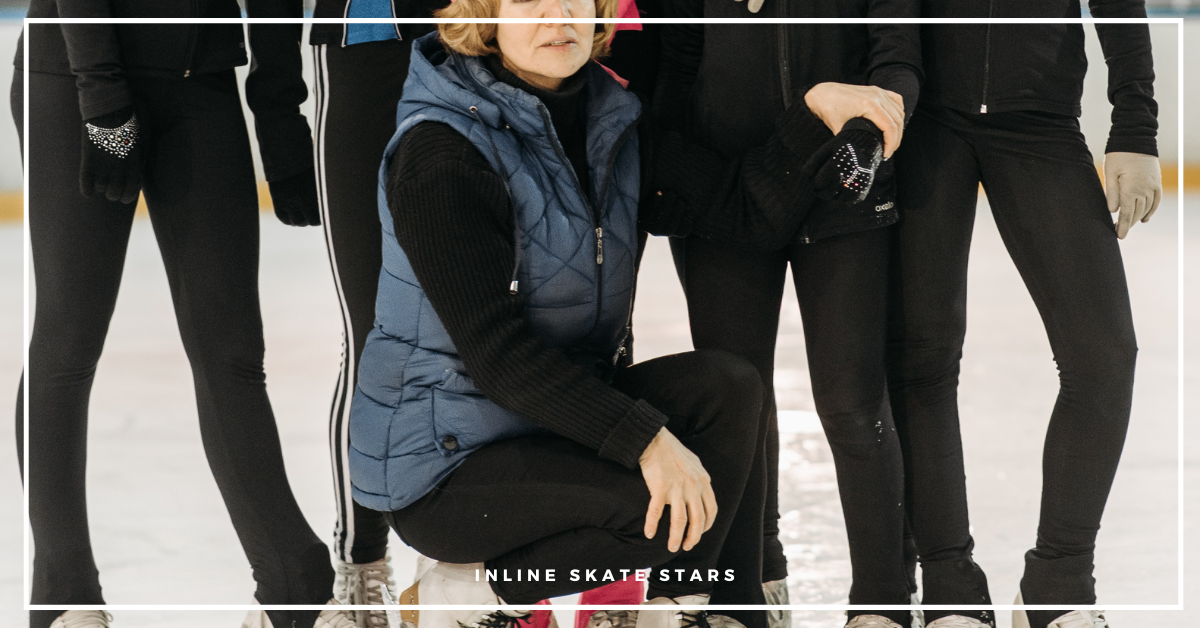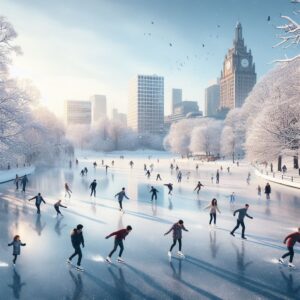Ice skating is a popular winter activity in the USA, but weather conditions sometimes make it difficult to skate outdoors. That’s where indoor ice skating comes in!
Indoor ice skating rinks provide a year-round opportunity to enjoy this fun activity, no matter what the weather is like outside.
In this guide, I cover everything you must know about indoor ice skating, including where to find indoor rinks, what to wear, how to get started, and more. So, let’s get to it!
Key Takeaways
- Indoor ice skating rinks provide a year-round opportunity to enjoy ice skating regardless of the weather.
- Indoor ice skating requires proper clothing and equipment for safety and comfort.
- Indoor ice skating is a fun activity for families and children, as well as for competitions and events.
- Indoor ice skating provides a range of physical and mental health benefits.
- Learning the history of ice skating and fun facts about the activity can add to your appreciation and enjoyment.
What is Indoor Ice Skating?
Indoor ice skating is a fun and exciting activity that allows you to glide across the ice while enjoying the comfort of an indoor rink.
Unlike outdoor skating, indoor ice skating offers several benefits, making it a great alternative.
When I talk about indoor ice skating, I mean skating on a rink that is located indoors, typically within a building or a facility.
These rinks are maintained at a consistent temperature and humidity, ensuring the ice surface remains smooth and safe to skate on.
Compared to outdoor skating, indoor ice skating offers a range of benefits. For one, you don’t have to worry about the weather.
No matter the time of year, you can enjoy ice skating in a comfortable and controlled environment.
This means you can avoid the discomfort of freezing temperatures, snow, and sleet often accompanying outdoor skating.
Another benefit of indoor ice skating is that the ice is typically smoother and more consistent than outdoor ice.
This is because indoor ice rinks are designed to maintain a constant temperature, which allows the ice to freeze more evenly. This means you can enjoy a smoother and more enjoyable skating experience without dealing with cracks, bumps, or uneven patches of ice.
Moreover, indoor ice skating rinks are often equipped with amenities that make the experience more enjoyable.
These include changing rooms, lockers, snack bars, and entertainment facilities. You can also take advantage of skating lessons or rent equipment on-site to help you get started or improve your skills.
Where to Find Indoor Ice Skating Rinks
There are many options for finding the best indoor ice skating rinks in the USA. Some of the top indoor ice skating rinks include:
- Rockefeller Center Ice Rink – New York, NY
- The Rinks – Anaheim, CA
- The Skating Club of Boston – Boston, MA
- Maggie Daley Park Ice Skating Ribbon – Chicago, IL
- The Ice at Canalside – Buffalo, NY
- Solar4America Ice – San Jose, CA
- The Ice Rink at the Cosmopolitan – Las Vegas, NV
- The Ice Factory – Kissimmee, FL
- The Ice Palace – Tampa, FL
- The Kettler Capitals Iceplex – Arlington, VA
Each indoor ice skating rink has its unique features and amenities. For example, the Rockefeller Center Ice Rink in New York City is located in the heart of Midtown Manhattan and offers stunning views of the surrounding skyscrapers.
The Skating Club of Boston is a historic skating club that has been around since 1912 and has hosted several national and international skating events.
The Maggie Daley Park Ice Skating Ribbon in Chicago is a winding path of ice perfect for skaters who want to take in the city skyline while they skate.
Comparison of Rinks in Different Regions
If you’re unsure which indoor ice skating rink to visit, consider looking at rinks in different regions of the USA.
The East Coast has several historic indoor ice skating rinks, such as the Skating Club of Boston and the Ice Palace in Tampa, FL.
The West Coast has several modern rinks, such as Solar4America Ice in San Jose, CA, and The Rinks in Anaheim, CA.
The Midwest also has several great rinks, such as the Maggie Daley Park Ice Skating Ribbon in Chicago, IL, and The Ice at Canalside in Buffalo, NY.
How to Find Local Indoor Ice Skating Rinks
If you’re looking for an indoor ice skating rink in your local area, there are several ways to find one.
You can use online resources, such as Google Maps or Yelp, to search for indoor ice skating rinks near you.
Many cities and towns also have websites that list local rinks and their hours of operation.
Finally, you can ask friends or family members who live in your area for recommendations on the best indoor ice skating rinks.
Cost of Indoor Ice Skating
The cost of indoor ice skating varies depending on the rink and the time of day. Typically, you can expect to pay between $10 and $30 for admission and skate rental.
Many rinks also offer discounted rates for children, seniors, and groups. Some rinks also offer season passes or membership programs that allow you to skate for a reduced rate.
What to Wear for Indoor Ice Skating
Indoor ice skating can be a fun and exciting activity, but it’s essential to dress appropriately for comfort and safety. Here are some clothing recommendations for comfortable and safe skating:
- Dress in layers: The temperature inside the rink can vary, so it’s essential to dress in layers that can be easily removed or added as needed. Start with a moisture-wicking base layer to keep sweat away from your skin, then add a warm layer like a sweater or fleece. Finish with a wind-resistant outer layer like a jacket.
- Wear comfortable and warm socks: A pair of thick, warm socks will help keep your feet warm and comfortable. Avoid cotton socks as they tend to absorb moisture, which can make your feet cold and uncomfortable.
- Wear pants or leggings: Choose comfortable pants or leggings that allow for ease of movement. Avoid jeans as they are not stretchy and can restrict your movement.
- Gloves or mittens: Wear gloves or mittens to keep your hands warm and protect them from blisters. Look for gloves or mittens made of synthetic materials that are waterproof and breathable.
- Helmet: While helmets are not always required, they are recommended, especially for beginners or young skaters. Helmets can protect you from head injuries in case of a fall.
In addition to clothing, here are some equipment recommendations for indoor ice skating:
- Skates: Wear proper ice skates that fit well and are comfortable. You can rent your skates at the rink if you don’t have them.
- Skate guards: Skate guards are plastic covers that protect the blades of your skates when you’re not on the ice. They are essential to prevent damage to the blades and ensure they stay sharp.
- Knee and elbow pads: While knee and elbow pads are not always necessary, they can provide extra protection in case of a fall. They are especially recommended for beginners or those who are prone to falls.
Check out this complete guide to learn more about what to wear for ice skating indoors.
Check with your local rink or sports store if you want to buy or rent skating equipment. Many rinks offer rental skates and other equipment, while sports stores often sell a wide range of skating equipment. Make sure to choose equipment that fits well and is comfortable.
How to Get Started with Indoor Ice Skating
If you’re new to ice skating, getting started can feel intimidating, but with the right tips and techniques, you’ll be gliding across the ice in no time.
Here’s everything you need to know about getting started with indoor ice skating:
Basic Techniques for Beginner Ice Skaters
Before you hit the ice, it’s essential to know the basics. First, make sure you have the right equipment, including ice skates that fit well and are properly sharpened.
Once on the ice, stand with your feet shoulder-width apart and your knees slightly bent. Keep your arms out in front of you for balance, and push off gently with one foot.
Alternate pushing off with each foot, and focus on keeping your movements smooth and controlled.
Safety Tips for Indoor Ice Skating
Safety should always be a top priority when ice skating, especially if you’re new to the sport.
Ensure you wear a helmet, gloves, and other protective gear as necessary. Stay aware of other skaters on the ice, and always skate in the same direction as the other skaters.
If you feel yourself losing your balance, try to relax and fall gently to the side to avoid injury.
Group and Private Lessons Available at Indoor Rinks
If you’re serious about improving your skating skills, consider taking lessons at an indoor rink.
Many rinks offer group and private lessons for skaters of all levels, from beginners to advanced.
A skating instructor can help you perfect your technique, work on your balance, and give you personalized tips and feedback.
How to Improve Your Skating Skills
There are many ways to improve your skating skills, including regularly practicing, taking lessons, and watching videos of professional skaters.
You can also try new techniques and moves, such as skating backward or attempting a spin.
As you become more comfortable on the ice, challenge yourself with new goals and skating drills.
Different Types of Ice Skating
It’s important to know that there are different types of ice skating, each with unique techniques and skills.
Figure skating, for example, focuses on artistic and technical skills, while ice hockey is a fast-paced team sport that requires speed, agility, and strength.
Whether you’re interested in recreational skating or a more competitive sport, there’s a type of ice skating that’s right for you.
Indoor Ice Skating for Families and Children
Ice skating is a fun and exciting activity for families and children. Indoor ice skating rinks offer families a safe and controlled environment to bond and make memories.
Here are some tips and information to make your indoor ice skating experience with your family enjoyable and unforgettable.
Advantages of Indoor Ice Skating for Families and Children
Indoor ice skating rinks offer many benefits for families and children. One of the main advantages is the controlled environment, which ensures the safety of skaters.
The rinks are typically maintained regularly to provide the best possible skating surface. Additionally, indoor rinks offer a variety of activities such as lessons, games, and competitions for skaters of all ages and skill levels.
Family-friendly Indoor Ice Skating Rinks
When looking for an indoor ice skating rink for your family, it is crucial to consider the rink’s amenities and programs.
Many rinks offer family and group packages that include skate rentals and lessons. Some rinks also have party rooms that can be rented for birthday parties or other special occasions.
Check online or call the rink beforehand to inquire about special programs and events for families.
Tips for Introducing Children to Indoor Ice Skating
Introducing children to indoor ice skating can be an exciting and memorable experience. Before heading to the rink, ensure your child dresses appropriately in warm and comfortable clothing.
Teach your child how to put on and lace up their skates properly, and make sure they are comfortable and snug.
Start by holding your child’s hand and taking small steps on the ice. Encourage them to maintain their balance and glide on the ice.
Positive reinforcement and praise can go a long way in building their confidence and enjoyment of the activity.
Fun Skating Games and Activities for Kids
Indoor ice skating rinks offer a variety of fun skating games and activities for kids to enjoy.
One popular activity is ice bumper cars, like traditional bumper cars but on ice. Other fun activities include ice hockey, figure skating, ice dancing, and broomball.
Some rinks even have designated areas for younger children to skate with toys or other fun props.
Indoor Ice Skating for Competitions and Events
Indoor ice skating competitions are an exciting opportunity for skaters to showcase their skills and compete against others.
Indoor ice skating competitions are typically divided into figure skating and ice hockey. Figure skating competitions involve individual or pairs skating routines, while ice hockey competitions involve teams competing against each other.
Skaters are judged based on their technical ability, artistry, and overall performance. They perform a set of predetermined elements, such as spins, jumps, and footwork sequences.
Skaters may also incorporate their choreography and music into their routine.
Indoor Ice Skating Events in the USA
Many indoor ice skating events are held throughout the year in the USA. Here are some of the most popular events:
- US Figure Skating Championships: Held annually, this is the national championship competition for figure skating in the USA. Skaters compete in singles, pairs, and ice dance categories, with the top skaters advancing to the world championships.
- Four Continents Figure Skating Championships: This event is held annually and is open to skaters from North America, Asia, Africa, and Australia. It’s a major international competition that attracts top skaters worldwide.
- National Hockey League (NHL) Playoffs: The NHL playoffs are the culmination of the professional ice hockey season in the USA. The top teams from the regular season compete in a knockout tournament to determine the league champions.
How to Train for Indoor Ice Skating Competitions
Training for indoor ice skating competitions requires a lot of dedication and hard work. Skaters must build strength and endurance, develop technical skills, and work on artistry and performance.
Beginner skaters should build a solid foundation of basic skills, such as proper posture, balance, and edge control.
They should also develop their jumps and spins, essential in figure skating routines.
Intermediate and advanced skaters should focus on perfecting their technical skills and incorporating more difficult elements into their routines.
They should also work on developing their artistry and performance skills, such as expression, musicality, and interpretation of the music.
Professional skaters should work with experienced coaches and choreographers to create innovative routines showcasing their skills and personality.
They should also focus on maintaining their physical fitness and staying injury-free.
Health Benefits of Indoor Ice Skating
Indoor ice skating is a fun and great way to improve your overall health and well-being. Here are some of the physical and mental health benefits of indoor ice skating.
Physical Benefits:
Improved Cardiovascular Health: Ice skating is a low-impact aerobic exercise that can help improve your cardiovascular health. When you skate, your heart rate increases, which improves blood flow and oxygen supply to your muscles.
Muscle Strength: Skating also helps strengthen your muscles, particularly in the legs, core, and buttocks. It also improves your balance and coordination, which are essential for skating.
Weight Loss: Ice skating can also help you burn calories and lose weight. Ice skating burns between 640 and 850 calories every hour.
Mental Health Benefits
Stress Relief: Skating is a great way to relieve stress and anxiety. It releases endorphins, natural chemicals that make you feel happy and relaxed.
Improved Mood: Skating also helps improve your mood by increasing your self-esteem and confidence. It can also help you feel more social and connected with others, especially if you skate with friends or family.
Overall Wellbeing:
Better Sleep: Engaging in physical activity like skating can improve sleep quality, which is essential for overall health and well-being.
Increased Energy: Skating can also help boost your energy levels by increasing blood flow and oxygen to your muscles and brain.
It is important to note that individuals with certain health conditions, such as arthritis or diabetes, should consult with their doctor before engaging in ice skating.
Additionally, wearing proper protective gear, such as helmets and wrist guards, can help prevent injuries and ensure a safe skating experience.
Indoor Ice Skating | Wrapping Up
Indoor ice skating is a fun and exciting activity for people of all ages and skill levels. By following the tips and information provided in this guide, you can have a safe and enjoyable indoor ice skating experience.
Whether a beginner or an experienced skater, indoor ice skating is a great way to stay active and have fun all year round.




